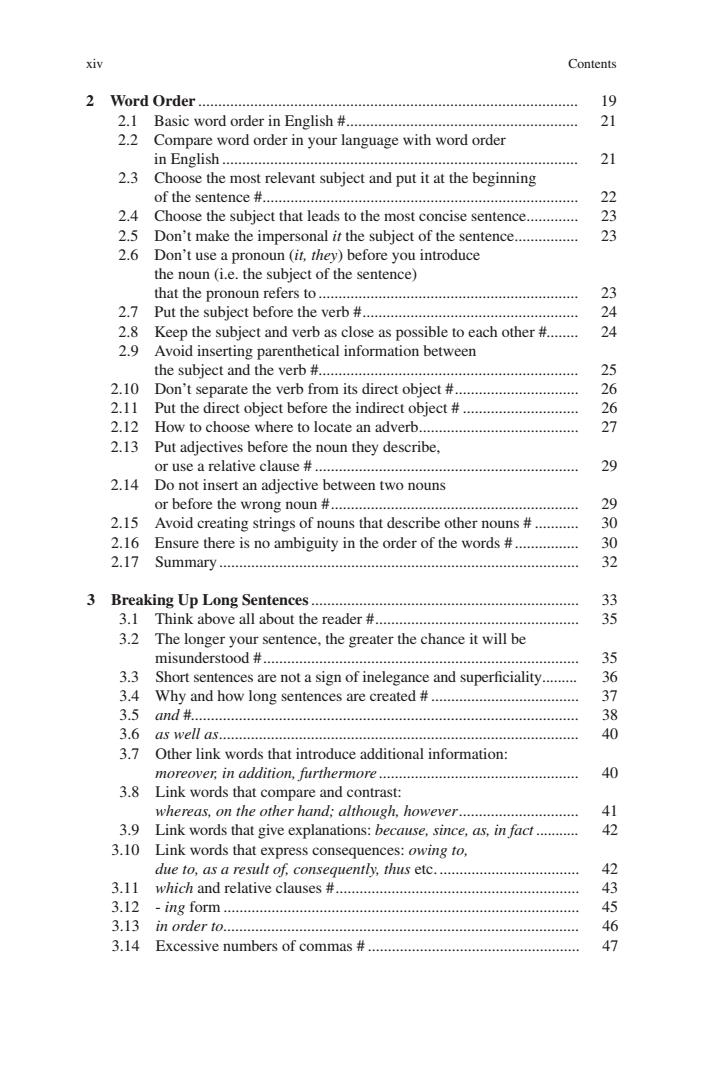正在加载图片...

xiv Contents 2 Word Order.............. 19 2.1 Basic word order in English# 21 2.2 Compare word order in your language with word order in English.… 21 2.3 Choose the most relevant subject and put it at the beginning 0 f the sentence#.… 22 2.4 Choose the subject that leads to the most concise sentence............. 23 2.5 Don't make the impersonal it the subject of the sentence................ 23 2.6 Don't use a pronoun (it,they)before you introduce the noun(i.e.the subject of the sentence) that the pronoun refers to. 23 2.7 Put the subject before the verb#. 24 2.8 Keep the subject and verb as close as possible to each other #....... 24 2.9 Avoid inserting parenthetical information between the subject and the verb# 25 2.10 Don't separate the verb from its direct object #...... 26 2.11 Put the direct object before the indirect object #............. 26 2.12 How to choose where to locate an adverb.................... 27 2.13 Put adjectives before the noun they describe, or use a relative clause 29 2.14 Do not insert an adjective between two nouns or before the wrong noun#. 29 2.15 Avoid creating strings of nouns that describe other nouns #.......... 30 2.16 Ensure there is no ambiguity in the order of the words #.............. 30 2.17 Summary.… 32 3 Breaking Up Long Sentences 33 3.1 Think above all about the reader #................... 35 3.2 The longer your sentence,the greater the chance it will be misundersto00d#… 35 3.3 Short sentences are not a sign of inelegance and superficiality........ 36 3.4 Why and how long sentences are created #.............. 37 3.5 e 38 3.6 as welas.. 40 3.7 Other link words that introduce additional information: moreover in addition,furthermore.. 40 3.8 Link words that compare and contrast: whereas,on the other hand;although,however................ 41 3.9 Link words that give explanations:because,since,as,in fact........... 42 3.10 Link words that express consequences:owing to, due to,as a result of,consequently,thus etc.... 42 3.11 which and relative clauses#... 43 3.12 -inng form....... 45 3.13 in order to...... 46 3.14 Excessive numbers of commas #...................... 47xiv Contents 2 Word Order ............................................................................................... 19 2.1 Basic word order in English #.......................................................... 21 2.2 Compare word order in your language with word order in English ......................................................................................... 21 2.3 Choose the most relevant subject and put it at the beginning of the sentence #............................................................................... 22 2.4 Choose the subject that leads to the most concise sentence............. 23 2.5 Don’t make the impersonal it the subject of the sentence................ 23 2.6 Don’t use a pronoun (it, they) before you introduce the noun (i.e. the subject of the sentence) that the pronoun refers to ................................................................. 23 2.7 Put the subject before the verb #...................................................... 24 2.8 Keep the subject and verb as close as possible to each other #........ 24 2.9 Avoid inserting parenthetical information between the subject and the verb #................................................................. 25 2.10 Don’t separate the verb from its direct object #............................... 26 2.11 Put the direct object before the indirect object # ............................. 26 2.12 How to choose where to locate an adverb........................................ 27 2.13 Put adjectives before the noun they describe, or use a relative clause # .................................................................. 29 2.14 Do not insert an adjective between two nouns or before the wrong noun #.............................................................. 29 2.15 Avoid creating strings of nouns that describe other nouns # ........... 30 2.16 Ensure there is no ambiguity in the order of the words # ................ 30 2.17 Summary.......................................................................................... 32 3 Breaking Up Long Sentences................................................................... 33 3.1 Think above all about the reader #................................................... 35 3.2 The longer your sentence, the greater the chance it will be misunderstood #............................................................................... 35 3.3 Short sentences are not a sign of inelegance and superficiality......... 36 3.4 Why and how long sentences are created # ..................................... 37 3.5 and #................................................................................................. 38 3.6 as well as.......................................................................................... 40 3.7 Other link words that introduce additional information: moreover, in addition, furthermore .................................................. 40 3.8 Link words that compare and contrast: whereas, on the other hand; although, however.............................. 41 3.9 Link words that give explanations: because, since, as, in fact ........... 42 3.10 Link words that express consequences: owing to, due to, as a result of, consequently, thus etc. ................................... 42 3.11 which and relative clauses #............................................................. 43 3.12 - ing form ......................................................................................... 45 3.13 in order to......................................................................................... 46 3.14 Excessive numbers of commas # ..................................................... 47